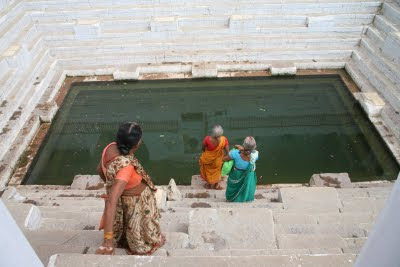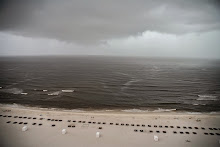
Early risers come to bathe in the holy Ganga Ji. Residents of the city have the honor of bathing in the holy water every morning and are considered very lucky to have been reborn here. The mood ranges from pious submersion to playful splashing to pragmatic bathing, complete with soap and shampoo.

Holy Cow! Literally. All cows in India are considered sacred, and the ones residing in Banaras are no exception. They wander the streets and their tiny alleyways, many times creating traffic jams for pedestrians and motorscooters. We quickly learned to respect and fear the cow after one headbutted Max in the chest. Normally they are docile, however Max was wearing a loud red shirt, which really turns them on. The cows also create a lot of cow dung which is ubiquitous on all city streets. So much so that sometimes you must only look down to make sure you don't step in shit. (Which also is considered lucky.) Although they are sacred, many of them are abandoned by their owners and left to the will of the people. In a country where many people can barely afford to feed themselves, it is not uncommon to see the cows foraging in trash piles. Many households who keep a charity jar for the homeless and the temple also set aside money for "poor cows."

Serious waste problem. Most Hindus believe that the Ganga is so holy that it can not be polluted, spiritually or physically. Many believe that the water has the ability to clean itself. Even scientifically minded "modern" Hindus have told us that Ganga water is the only water in the world that will never putrefy. Unfortunately this is not true, as the Ganga is now one of the most polluted waters in the world by any measurement. E-Coli and other common bacteria are rampant and many times the levels of other bodies of water. Though there have been recent internationally supported clean up efforts, they come up against formidable obstacles of faith, lack of infrastructure, and the exponentially increasing number of cheap plastic goods and wrappings that make their way to the banks each day.
Our first day on the ghats. A ghat is a series of steps that lead to a holy body of water. In Varanasi, the ghats line the entire length of the holy city forming a sweeping crescent. Each ghat has a specific temple, shrine, or purpose. We stayed on Assi Ghat, the last ghat in Kashi's holy geography. This allowed us to observe the length of the city every day, observing pilgrims, cremations, and religious offerings in a walking meditation.

Flowers, coconuts, and powdered dye, simply called color, can be bought from many offering-wallas throughout the city.

Ghee candles set in rose pedals on a banana leaf dish. These offerings are lit and set afloat the water. The act both blesses the water and the pilgrim. Every day Kara was propositioned by one particular lady selling these offerings at the evening arthi (to be explained later.) Kara promised to buy one on the last day we were in Banaras. Their daily exchange grew into a friendship and we came to expect her big smile every night.

Here a young boy sets a ghee candle onto the Ganga.

The evening arthi. Every day at dawn and post-sunset, Brahmin priests come to this stage to bless the holy water and make offerings to Shiva, the mythological founder of the city. Hundreds of pilgrims, tourists, and local worshipers throng to this main ghat- Dasaswamedh- to observe and participate in this holiest of blessings. For the 11 days we stayed in Kashi, we went every night. It was a beautiful ritual that drew us in every evening, regardless of our spiritual and religious beliefs. Many people told us that we were very lucky to have seen the arthi once, let alone so many times. Millions of pilgrims travel thousands of kilometers to see this rite performed only once in their lives. Filled with music, bell ringing, rose scattering, and conch-blowing, the evening arthi is one of the most mystical and powerful experiences to be had in Banaras. Max's favorite part of the ritual is the fire offering: A chalice of ghee is set alight and a Brahmin priest offers it to the Ganga Ji in a rhythmic circular dance.

Here a Brahmin priest, who turned out to be the husband of Kara's flower selling friend mentioned above, uses incense sticks to bless the water and the crowd. Later that night we joined them for a meal at their house. Our friend was both impressed and delighted that we were so interested in the arthi and her family's livelihood.

Kara in our hotel in her improvised salwaar suit.

Kara taking pictures in an ancient alleyway.

We happened to arrive in Banaras during the month long Shiva festival. We wondered how the Shiva festival was any different than a normal month in Varanasi as the whole city is dedicated to Shiva himself. Here, hundreds of pilgrims wait in a queue for their chance to view the god image (a process called darshan,) at Kashi Vishwanath--more commonly referred to as the Golden Temple.

Snake charmers on the ghats. During the Shiva festival there is a special day dedicated to snakes and the charmers were out in full force. Yes, these are real cobras.

Walking up to a Shiva temple. This temple is particularly holy for South Indians and holds some of the oldest god images in the city.

Max gets a shave and a haircut on the ghats.

Inside a temple. Shiva's mount- the bull, presides over the meeting of Brahmin priests.

Sidenote, Varanasi is just 8 kilometers from one of the most important places in all of Buddhism-Sarnath. We took a break from our daily routine of yoga, Shiva worshipping, and arthi-watching to check out the site where the Buddha gave his first sermon. The Buddhist emperor Ashoka built a huge stupa and a monastery here in Deer Park in 250 B.C. In the foreground are the ruins of the monastery and behind it, one of the oldest stupas in the world. It was overwhelming to visit the site of such a world historic event.

Back in Banaras, Kara gets mahendi (henna). The owner of the restaurant that we frequented near Dasaswamedh insisted that Kara come to his house so that his wife could decorate her hands and arms in traditional celebratory Indian designs.

Many young pilgrims wanted to take pictures with Max. Hand-holding between members of the same-sex is very common in India and all of South Asia... even amongst strangers.

Temple on the water.

Kara and Max separated for maybe 5 minutes one morning after yoga. When Kara returned to the spot they were supposed to meet, she was called over by a young man saying, "your friend, he is here!" Convinced that it was another tout trying to sell her something she adamantly stayed put in her spot until a group of men beckoned her over, explaining that her bearded friend was getting a massage. Max's masseur had shook his hand in introduction and started massaging it instantly. Max was powerless to resist and soon found himself being massaged by not one, but two men on a wooden platform being observed by a group of 20 men.

Walking to a tirtha, or holy pool.

Max and Kara have a linga blessed by a Brahmin priest on Dasaswamedh Ghat. That's all there is to say about that.
Varanasi. Kashi. Banaras. There is so much about this city that can not fit into a single blog entry, or even be explained by words. Coming here gave us a window into the labyrinthine nature of Hindu theology and culture. After visiting this place three times, Kara can now accurately say that Banaras is the weirdest and most interesting place she has ever been. Max thinks that Kashi is like quantum physics: if you think you understand it perfectly, you don't.
In light,
Kara and Max.




4 comments:
Where the hell are you now? I am counting down this last month !!!! I can't wait to see you!!!!!
xoxoxoxoxoxox
People told me India was a place of great color and now I can see through your pictures and your words a bit of it. How amazing to watch you both sink into a place so different and so full of delights and consternations. I like you ending with the Richard Feyneman quote. I've been reading a book called Zen Physics. Cannot wait to discuss this and a myriad of other things when next I see you --one or the other or both. Much love to you two/too. We miss you and speak of you every single day.
Won't stop, won't quit.
This just keeps getting better.
<3
That's really great to see.
I belong to the holy city of varanasi and I got to know a lot of things from this blog itself, thanks a lot. I am also on a project for the city. I'll come back to you for your awesome reviews :)
Checkout fb.com/mybanaras
Post a Comment